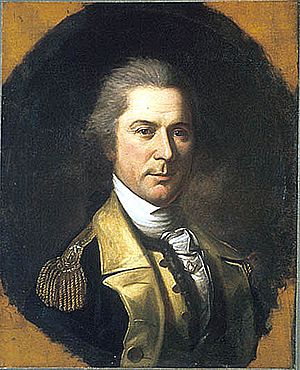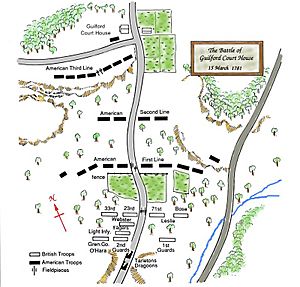Otho Holland Williams facts for kids
Quick facts for kids
Otho Holland Williams
|
|
|---|---|

Painting of Williams in 1784 by Charles Willson Peale
|
|
| Born | March 1, 1749 Prince George's County, Maryland |
| Died | July 15, 1794 (aged 46) Woodstock, Virginia |
| Allegiance | |
| Service/ |
Continental Army |
| Rank | Continental Army
|
| Unit | Continental Army
|
| Commands held | Continental Army
|
| Battles/wars | American Revolutionary War |
| Other work | 1st Commissioner of the Port of Baltimore |
Otho Holland Williams (born March 1, 1749 – died July 15, 1794) was a brave officer from Maryland who fought in the Continental Army during the American Revolutionary War. He took part in many important battles in New York, New Jersey, and the Southern states. He rose through the ranks, eventually becoming a Brigadier General.
Williams grew up on a farm in Prince George's County, Maryland. He became an orphan at age thirteen and learned to work in a clerk's office. Later, he moved to Baltimore for a similar job. When the war began, he joined the army and quickly became an officer. He was captured by the British during the Battle of Fort Washington and held prisoner in New York City.
After his release, Williams returned to lead the 6th Maryland Regiment. He played a key role in major battles like Camden, Guilford Court House, and Eutaw Springs. Near the end of the war, he was promoted to brigadier general. After the war, he helped manage the Port of Baltimore and founded the town of Williamsport, Maryland, which was named after him.
Contents
Early Life and Work
Otho Holland Williams was born on March 1, 1749. His family had moved to North America from Wales several generations before. For his first year, he lived with his parents, Joseph and Prudence Williams, in Prince George's County, Maryland. Then, his family moved to Springfield Farm near what is now Williamsport, Maryland.
When Williams was thirteen, his father passed away. He was then cared for by his uncle, Mr. Ross, who worked in a clerk's office in Frederick County, Maryland. Williams studied hard and soon took charge of the office himself. At age eighteen, he moved to Baltimore for a similar job. In 1774, he returned to Frederick and started his own business.
Joining the War Effort
In June 1775, the Continental Congress asked for soldiers to fight for independence. Otho Holland Williams joined a rifle company from Maryland as a first lieutenant. His company soon marched to the Siege of Boston. While there, Williams was promoted to lead the company.
In June 1776, his company became part of the Maryland and Virginia Rifle Regiment. Williams was promoted again, this time to major.
Captured at Fort Washington
The regiment saw its first major fighting at the Battle of Fort Washington. During this battle, Williams was captured by the British army. He was taken to New York City and, because of his rank, was allowed to move around the city on his word of honor.
While he was a prisoner, British officers sometimes tried to make fun of American prisoners. One high-ranking officer asked Williams what his job was before the war. Williams bravely replied that his job taught him "to resist tyranny and punish insolence." This answer upset the officer. Williams was then arrested and put in a small, unventilated jail cell. He shared this cell with another famous American, Ethan Allen. The poor conditions in prison affected his health for the rest of his life.
Return to Command
After a prisoner exchange in January 1778, Williams was finally set free. While he was in prison, he had been promoted to colonel and given command of the 6th Maryland Regiment.
When he returned, he found his regiment had very few soldiers and they were not well-clothed. He wrote to the governor of Maryland, saying he wanted to join the army quickly. He worked hard to improve the discipline of his troops. Soon, the 6th Maryland Regiment became known as one of the best units in the entire army.
Fighting in the South
After a failed attempt to capture Savannah, Georgia, the American army in the South retreated to Charleston, South Carolina. British General Sir Henry Clinton surrounded Charleston, trapping the American forces.
General Benjamin Lincoln, the American commander, sent messages asking for help. In April 1780, George Washington sent General Johann de Kalb with 1,400 soldiers from Maryland and Delaware. Williams served as a key assistant to General De Kalb.
Battle of Camden
The American forces in the South were then led by General Horatio Gates. Williams served as a deputy assistant to Gates. On August 16, 1780, the American and British armies met at the Battle of Camden in South Carolina.
General Gates made several mistakes, and the British, led by Charles Cornwallis, won a major victory. The American army was forced to retreat. Williams was positioned at the back of the army and could not join the main fight until the end. General De Kalb was badly wounded and died three days later. Before he died, he praised the Maryland troops for their bravery.
Battle of Guilford Court House
After a successful retreat, General Nathanael Greene decided to fight General Cornwallis at Guilford Court House in North Carolina on March 15, 1781. Greene chose the battleground carefully.
During the battle, the British broke through the first two American lines. They then attacked the third line, which included the 1st Maryland Regiment and the 2nd Maryland Regiment. A British unit called the Brigade of Guards broke through the 2nd Maryland Regiment and captured some cannons.
The 1st Maryland Regiment charged forward and pushed back the British forces they were fighting. Then, they turned to face the oncoming Guards unit. After a short fight, the 1st Maryland Regiment bravely charged and defeated the Guards.
General Greene, who could not see this part of the battle, had already ordered a retreat. So, the Maryland troops had to pull back without support. During this retreat, the 6th Maryland Regiment under Williams again protected the rear of the army. They held off the British, allowing Greene to move his forces to safety. Because of Williams's courage, General Greene made him the army's chief assistant.
Battle of Eutaw Springs
The Battle of Eutaw Springs involved two main parts. In the first part, General Greene gave Williams a clear order: "Let Williams advance and sweep the field with his bayonets."
The 6th Maryland Regiment charged and broke the British line, forcing them to retreat. This allowed the American army to take control of the British camp. However, the Americans then started to loot the camp. This gave the British time to form a new line, using a stone house for protection. The American army could not move them from this strong position later in the day.
Near the end of the war, General Greene sent Williams with important documents to Congress. On May 9, 1782, Williams was promoted to Brigadier General.
Life After the War
After the war, Williams returned to Maryland and settled in Baltimore. The Governor of Maryland soon appointed him Commissioner of the Port of Baltimore. This job was renewed when George Washington became the first President of the United States. Williams also became an early member of The Society of the Cincinnati, a group for officers who fought in the war.
In 1786, he married Mary Smith, and they had four sons. The next year, Williams bought his father's old farm near the Potomac River. He worked to improve the farm and planned out a new town called Williamsport, Maryland, which was named in his honor. Williams even wrote to President Washington in 1790, hoping Williamsport could become the new capital of the United States.
President Washington thought highly of Williams. In 1792, when another general declined a promotion, Washington asked Williams to become a Brigadier General in the American Army. This would have made Williams the second-in-command. However, Williams declined the offer, saying his health was poor and he didn't want the position. Still, in December 1792, Williams accepted an invitation to serve as a judge for Baltimore County.
Williams's health continued to get worse. In 1793, he traveled to Barbados hoping the sea air would help him feel better. In 1794, while traveling to Sweet Springs, Virginia, he became too ill to continue. Otho Holland Williams died on July 15, 1794, at the age of 46. He was buried under a simple monument on a hill at his home in Williamsport. His wife passed away a year later, leaving their children to be raised by her father.


